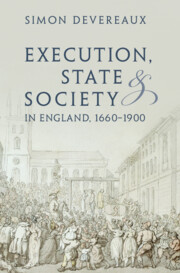Book contents
- Execution, State and Society in England, 1660–1900
- Series page
- Execution, State and Society in England, 1660–1900
- Copyright page
- Dedication
- Contents
- Figures
- Images
- Tables
- Acknowledgments
- Abbreviations
- 1 Introduction
- 2 Executions for Treason, 1660–1820
- 3 Changing Cultures of Execution: Religion and Feeling, 1660–1770
- 4 Changing Cultures of Execution: Reason and Reforms, 1770–1808
- 5 The Murder Act: Anatomization, 1752–1832
- 6 The Murder Act: Hanging in Chains, 1660–1834
- 7 The “Bloody Code” Debated, 1808–1821
- 8 The “Bloody Code” Diminished, 1822–1830
- 9 The Vicissitudes of Public Execution, 1830–1900
- 10 Conclusion
- Archival and Digital Sources
- Index
1 - Introduction
Published online by Cambridge University Press: 12 October 2023
- Execution, State and Society in England, 1660–1900
- Series page
- Execution, State and Society in England, 1660–1900
- Copyright page
- Dedication
- Contents
- Figures
- Images
- Tables
- Acknowledgments
- Abbreviations
- 1 Introduction
- 2 Executions for Treason, 1660–1820
- 3 Changing Cultures of Execution: Religion and Feeling, 1660–1770
- 4 Changing Cultures of Execution: Reason and Reforms, 1770–1808
- 5 The Murder Act: Anatomization, 1752–1832
- 6 The Murder Act: Hanging in Chains, 1660–1834
- 7 The “Bloody Code” Debated, 1808–1821
- 8 The “Bloody Code” Diminished, 1822–1830
- 9 The Vicissitudes of Public Execution, 1830–1900
- 10 Conclusion
- Archival and Digital Sources
- Index
Summary
Recent work on execution emphasizes broad similarities in the character and causes of changing practices across the western world, as well as the strength of resistance to reform in England before the 1830s. In fact, five features gave rise to a distinctive path of change in England following the Restoration of 1660. First, the variable scale of enforcement from one place to another contained the potential excesses of England’s “Bloody Code.” They were additionally contained, secondly, by the “early” advent of constitutional monarchy, which made parliament – and new urban elites – partners in making and enforcing the laws. England’s “urbane” peoples derived particular strength, thirdly and fourthly, from the unique extent of urbanization in England and the vigorous public sphere to which it gave rise. Finally, the experience of London, by 1750 the largest European city, compelled changing practices which gave those people ascendancy in public political culture by the 1830s.
- Type
- Chapter
- Information
- Execution, State and Society in England, 1660–1900 , pp. 1 - 29Publisher: Cambridge University PressPrint publication year: 2023

